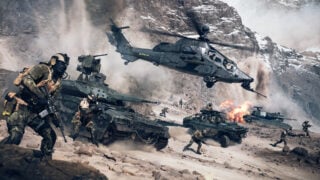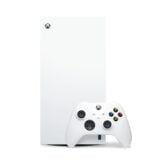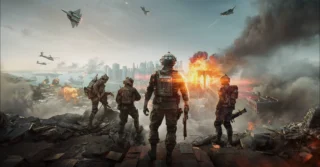As the Battlefield 6 Open Beta kicks off, its designers tell us what makes the perfect map
The game’s designers tell VGC what makes a map iconic

Shooters live or die on the quality of their maps. The most formative memories we all have with the genre are indelibly tied to specific, iconic maps.
Modern Warfare’s Shipment and Crash. Halo 3’s The Pit and Valhalla. Battlefield 3’s Caspian Border. Those who have played them learned to know them inside-out.
This weekend, players will get their first chance to play Battlefield 6 as the game’s open beta kicks off. The beta will return next weekend, ahead of the full game’s launch in October.
At the recent Battlefield 6 global multiplayer reveal event, we sat down with Battlefield 6 design director Shashank Uchil and Criterion‘s Fasahat Salim to discuss the philosophy behind the new game’s maps, as well as player expectations and the game’s scale.
“I think we knew very early on that we wanted to go back to a modern Battlefield,” said Salim.
“The second we say that, we think about Battlefield 3 and Battlefield 4. And for us, that was an exciting thing. We understand the things that resonated with players. How can we take all of the things that we know are good in Battlefield 3 and Battlefield 4, bring them into Battlefield 6, and then really take them to the next level?
“There’s a lot of things that people will see as familiar Battlefield things, but they’ll experience them in a way that they almost certainly haven’t experienced before, because the level of depth that we’ve gone into to try and make that an immersive experience and also make that part of the tactical decision-making is a big thing for us.”

Battlefield 6 will launch with a wide variety of map sizes, and environments. While some maps will suit certain playstyles better than others, the developers behind Battlefield 6 are insistent that no matter how you play, or which class you use, there will be a role for you in every map.
“We want to make a map that suits every type of player,” Uchil told us. “They could be infantry players. So we want to make sure we have good infantry maps. Maybe a player who likes tanks, vehicles. OK, let’s make a map that’s good for infantry and tanks.
“You know what? I like helicopters. Let’s make a map for that. And then the jets, which I’m really bad at, but there are players who are really good at jets. I don’t know how they do it, but they are there. So let’s make a map that caters to them as well.”
Due to the power afforded by modern hardware, massive maps have become the norm in the shooter genre. Thanks to the likes of Fortnite and Warzone, players have come to expect a certain level of scale. However, for Battlefield 6, the team isn’t interested in scale for the sake of it.
“Scale is not everything. Right?” says Uchil. “Well, just because you have X kilometers doesn’t mean it’s going to be a good map, because then if you make a really big, map, you’re going to fill it up with stuff. Then it becomes more of an open world. And then you start compromising on a bunch of stuff.”

One of the game’s main pillars is the way in which its maps can be blown up. Destruction in Battlefield 6 has never been more realistic, or had more effect on gameplay. However, as with map size, processing power is no longer a roadblock for destruction, so how does the team behind Battlefield 6 balance the carnage with a compelling multiplayer experience?
“Destruction is great, but if you destroy everything, then it’s not so great,” says Uchil.
“So what we do is, as a fundamental rule, everything is destructible, provided it’s the right material. So if it’s wood, it’s going to break like this. If it’s a thin wall, it’s going to break like that. If it’s thick concrete, it breaks like this. Stones probably don’t break. Metal will bend. OK, we know that as an ingredient, right?
“So tactically, a lot of the destruction also persists in the world. So in that same example, if I brought down the building or I shot out the wall, that destruction would result in debris on the floor. And that can then give me an avenue to get up to that top floor where those guys are.
“A level is always evolving with the overall battle and the experience that’s underway, so a lot is going on there. And I think it’s just a matter of how players kind of engage with destruction now, because I keep telling everyone, with Battlefield 6 engage with the environment because that’s what we want you to do, and you’ll realize that ‘wow, that’s opening up a whole world of possibilities’.”

What won’t be returning for Battlefield 6 is Levelution. This was the name given to the map-changing events that could be triggered in Battlefield 4, the most famous of which being the skyscraper that could be brought to its knees in the middle of a multiplayer match. While the team loved working on Levelution, they feel that it was a spectacle that was amazing once, but didn’t feel dynamic enough overall.
“You look at it and you have eyeballs on it,” says Uchil, discussing the iconic skyscraper collapse.
“Everybody stops and watches it. The issue with that is it gets stale very fast. Because if you do it once, it’s cool. And if you do it over and over again, it’s like, okay, the thing is falling down again. What’s the big deal? That’s why we lean into more of the organic.”

“A game like this is probably exclusively restricted by the available tech,” says Salim. “How far can we push it? Levolution was great. Levolution is something that we’re really proud of.
“Destruction is big for us. We’re making it into a tactical thing that players can think about and use to their advantage. So it’s not just a case of there being an aesthetic to the destruction. That’s still there. It still looks and feels amazing. But you can actually be slightly more nuanced with how you’re blowing things up or how you’re engaging with environments.
“So I think that can only come as technology evolves. And we have, thankfully, a really strong engine in Frostbite. So as the years have gone on, Frostbite has also developed with that, and obviously the tech now allows us to do the things that we’re doing, and a designer can only be excited for where we’re heading next.”














